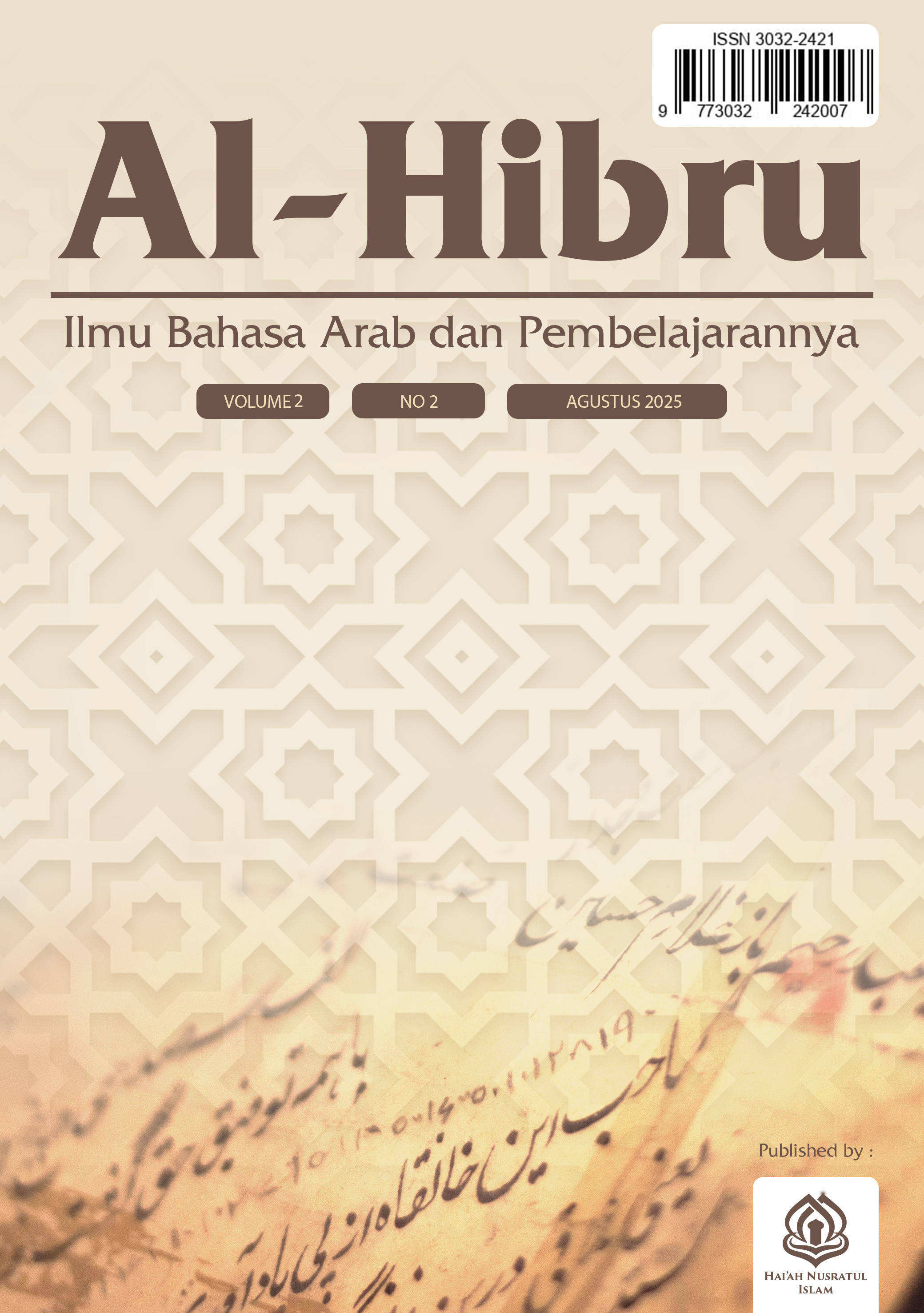PHONOLOGICAL TRANSFORMATION IN ARABIC: A HISTORICAL STUDY OF I'LAL RULES BASED ON THE VIEWS OF AL-KHALIL BIN AHMAD AL-FARAHIDI
DOI:
https://doi.org/10.59548/hbr.v2i2.381Keywords:
I'lâl, Arabic Phonology, Shorof, Letter Illat, Al-Khalil Bin Ahmad Al-Farahidi, Fi'il Mu'talAbstract
This study discusses the phonological transformation in Arabic through a study of the rule of i'lâl - a process of phonetic change that occurs on the letters of illat (alif, wau, and ya') - in a historical perspective, by highlighting the contribution of Al-Khalil bin Ahmad al-Farahidi's thought. This study uses a qualitative approach with a literature study method, which aims to classify and analyze the types of i'lâl as described in the framework of shorof science (Arabic morphology). The results show that i'lâl has three main forms, namely ibdāl (replacement), ḥadhf (omission), and taskīn (harmonization), all of which are arranged to ease pronunciation and maintain harmony between sound and word structure. Al-Khalil bin Ahmad al-Farahidi is seen as the main figure in the early formulation of i'lâl theory, where his ideas not only provide a scientific foundation in morphological studies, but also show his accuracy in considering practical phonetic aspects in Arabic. Thus, this study emphasizes the importance of integration between phonology and morphology in understanding the dynamics of word formation, as well as the relevance of classical scientific heritage in the context of modern linguistics.
References
Al-Hadi Ab Hadi, Amin, and Firuz-Akhtar Lubis. 2023. "Contributions of Al-Khalil Bin Ahmad Al-Farahidi Toward the Development of Arabic Linguistics." BITARA International Journal of Civilizational Studies and Human Sciences 6(4): 52-63. http://www.bitarajournal.com.
Al-Khalil Bin Ahmad Al-Farahidi, Contribution, Damhuri Dj Noor, and Muhtar I Miolo. 2019. "In Arabic Language Sciences." Journal of Language (e-Journal) IAIN Sultan Amai Gorontalo 4(2): 148-60. http://journal.iaingorontalo.ac.id/index.php/al.
Amrulloh, Kahfi, Stai Masjid, and Syuhada Yogyakarta. 2023. "Quran-Based I'Lal Learning (Study of Quran Surah Yasin Analysis) Non-Arab Muslims to Be able to Read, Understand, and Practice the Contents of the Quran." 6: 140-56.
Gani, Saida, and Berti Arsyad. 2019. "THEORITICAL STUDY OF LANGUAGE INTERNAL STRUCTURE (Phonology, Morphology, Syntax, And Semantics)." `A Jamiy: Journal of Arabic Language and Literature 7(1): 1. doi:10.31314/ajamiy.7.1.1-.20.2018.
Ghofur, M. Abdul, Amak Fadholi, and M. Halim Tauhid. 2024. "Morphological Analysis of Fi'il Madhi and Fi'il Mudhori in the Qur'anic Verse of Surah An-Naba Juz 30." As-Sunniyyah 4(01): 32–38. doi:10.62097/assunniyyah.v4i01.1880.
Hakim, Muhammad Luqman. 2020. "Morphological Process of Wazan-Wazan Fiâ€TMIl Mazid and Its Meaning in Al-Quran Juz 28." Tarling: Journal of Language Education 3(2): 201–28. doi:10.24090/tarling.v3i2.3532.
Jamil, Jamat. 2014. "Fiil Mu'tal in the Book of Akhlak Lil Banin Juz 1 by Umar Bin Ahmad Baraja." Journal of Arabic Learning and Teaching 5(1): 28–32.
Lathifah Insani, Abdur Rahim, and Ahmad Asrof Fitri. 2022. "Learning Shorof in the Spread Method Program (Spirit of Learning and Arabic) at the Online Islamic School." PUSTAKA: Journal of Language and Education 2(4): 129–47. doi:10.56910/pustaka.v2i4.192.
Mardiah, Zaqiatul, and Ahmad Khorin Junaedi. 2017. "Productivity and Blocking in Arabic Morphology System." Journal of Al-AZHAR INDONESIA HUMANITIES SERIES 3(2): 109. doi:10.36722/sh.v3i2.201.
Muhammad, Karya, Nawāwī Bin, and Umar Al. 2022. "Tadris Al-'Arabiyyah." 1(2): 214-26.
Muhammad Zahid 'Afafarrasyihab Rahimadinullah, Mohammad Ahsanuddin, Irhamni, and Romyi Morhi. 2023. "Development of Word Root-Based Digital Dictionary for Shorof Mastery." Izdihar: Journal of Arabic Language Teaching, Linguistics, and Literature 5(3): 265–84. doi:10.22219/jiz.v5i3.23024.
Najah, Muhajirun. 2019. "Application of Shorof Learning for Beginner Learners Using the Language Acquisition Method." al Mahāra: Journal of Arabic Language Education 5(1): 117–40. doi:10.14421/almahara.2019.051-07.
Ni'mah Khoirotun, and Salamiyah Anisa'atus. 2024. "Ashwat Science in Arabic Language Learning." Humanist, Journal of Social Sciences and Humanities Vol 16 No1 (Vol 16 No 1 (2024): January): 36-49. http://www.e-jurnal.unisda.ac.id/index.php/Humanis/article/view/5729.
Pribadi, Moh. 2018. "Al-Khalīl's Contribution to the Development of Arabic Nahwu." Adabiyyāt: Journal of Language and Literature 1(1): 73. doi:10.14421/ajbs.2017.01104.
Qustulani, Muhammad. 2020. "Qawaidul Al Ilal for Beginners."
Suryanti, Neng. 2025. "Historical Development of Shorof Science: An Analysis of the Classical Scholars' Contribution to the Systematics of Arabic Morphology." 4 (April).
Umroh, Ida Latifatul, and Anis Mirwahatul Jannah. 2021. "Muhibbin Syah, Psychology of Learning (Jakarta: Rajawali Pers, 2015), 59 46." 2(2): 46-61.
Zainal, Moh, Abidin Aris, and M Yunus Abu Bakar. 2025. "Shorof Science in the Perspective of Philosophy of Science: A Review." 2.
Zubaidi, Muhammad Addib. 2024. "The Heritage of Kediri; A Comparative Study of the Concept of Teaching Kaidah I'lal by KH. Mundzir Nadzir and KH. Maisur Sindi." 4(2): 70-85.
Zuhriyah, Lailatul, Ahmad Sholihuddin, and Muhammad Thohir. 2018. "Morphological Affixation Process of Ism (Noun) in Arabic." Journal of Arabic Language Education and Linguistics 5(2): 292–313. doi:10.15408/a.v5i2.8976.
Downloads
Published
How to Cite
Issue
Section
License
Copyright (c) 2025 Vira Rahmadini

This work is licensed under a Creative Commons Attribution 4.0 International License.
- Share — copy and redistribute the material in any medium or format for any purpose, even commercially.
- Adapt — remix, transform, and build upon the material for any purpose, even commercially.
- The licensor cannot revoke these freedoms as long as you follow the license terms.
Under the following terms:
- Attribution — You must give appropriate credit , provide a link to the license, and indicate if changes were made . You may do so in any reasonable manner, but not in any way that suggests the licensor endorses you or your use.
- No additional restrictions — You may not apply legal terms or technological measures that legally restrict others from doing anything the license permits.
Notices:
You do not have to comply with the license for elements of the material in the public domain or where your use is permitted by an applicable exception or limitation .
No warranties are given. The license may not give you all of the permissions necessary for your intended use. For example, other rights such as publicity, privacy, or moral rights may limit how you use the material.













 Based on a work at
Based on a work at 